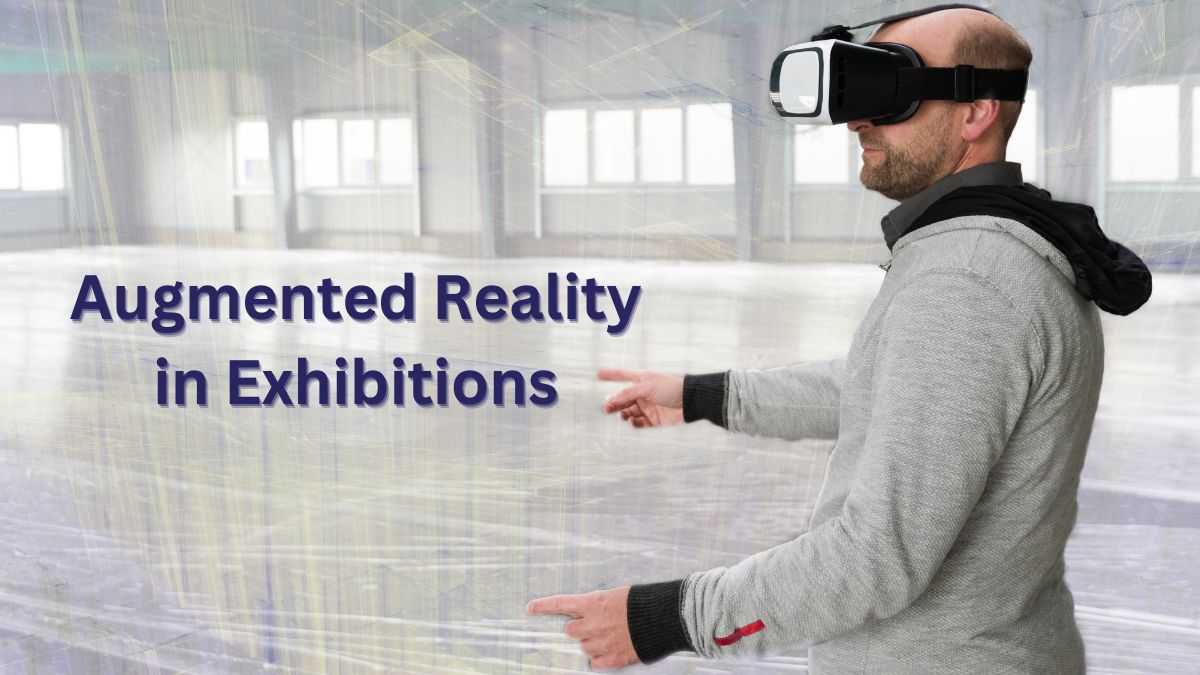Augmented Reality in Exhibitions, Virtual Reality vs. Augmented Reality, AR applications in Museums, Immersive Exhibition Experiences, AR-enhanced Visitor Engagement, Advantages of Augmented Reality in Exhibitions, Bringing Artifacts to Life with AR, Interactive AR Exhibits, Technology in Museum Displays, The Future of Augmented Reality in Exhibitions, Augmented reality technology for trade shows, AR solutions in trade show displays, AR integration in exhibition booths, AR applications for trade show exhibits, Augmented reality experiences in exhibition spaces, Virtual overlays for exhibition booths
Introduction:
In this blog post, we will explore the mesmerizing journey of augmented reality (AR) in exhibitions and museums, highlighting the transformative power it holds for the traditional museum experience. As we delve into the rise of augmented reality in exhibitions, we will examine the distinctions between virtual reality and augmented reality, uncover the various applications of AR in museums, and showcase the immersive and interactive experiences it offers. Discover the advantages of augmented reality in enhancing visitor engagement, bringing artifacts to life, and revolutionizing the way we interact with museum displays. Join us as we delve into the current state of Augmented reality technology for trade shows and gaze into the future, pondering the exciting potential it holds for the ever-evolving world of technology in museums. In recent years, augmented reality (AR) has revolutionized the way we experience exhibitions and museums. This cutting-edge technology seamlessly blends the virtual world with the real world, enhancing our interaction and understanding of various exhibits. In this blog post, we will explore the mesmerizing journey of AR in exhibitions, how it has transformed the traditional museum experience, and what the future holds for this rapidly advancing technology.
Section 1: Augmented Reality vs. Virtual Reality – The Distinction That Matters
One of the key distinctions that shapes the rise of AR solutions in trade show displays is the comparison between augmented reality (AR) and virtual reality (VR). While VR offers a fully immersive digital environment, AR merges the virtual and real worlds, overlaying digital content onto the physical surroundings. When it comes to AR applications in museums, this difference becomes crucial. AR provides immersive exhibition experiences by enhancing visitor engagement and allowing them to interact directly with artifacts, bringing them to life. Unlike VR, AR doesn’t isolate users from their physical surroundings, making it more conducive to collaborative and interactive experiences. This technology has opened up a world of possibilities in museum displays and offers promising advancements for the future of Augmented reality technology for trade shows. This section will delve into the key differences between augmented reality and virtual reality. The emergence of AR in the exhibition industry has disrupted the dominance of VR technology and opened up new avenues for engagement.
Section 2: AR Applications – Transforming Museums into Digital Playgrounds
The applications of augmented reality (AR) in museums have completely transformed these cultural institutions into captivating digital playgrounds. Unlike virtual reality (VR), which immerses visitors in a wholly digital environment, AR seamlessly integrates virtual elements into the real world. This technology, when applied in museums, creates immersive exhibition experiences that enhance visitor engagement. AR-guided tours take visitors on interactive journeys, allowing them to explore historical artifacts with contextual information and multimedia overlays. Virtual reconstructions bring ancient ruins and vanished civilizations to life, enabling visitors to visualize their past glory. By leveraging the advantages of augmented reality in exhibitions, museums are effectively bringing artifacts to life, making them dynamic and interactive. Interactive AR exhibits invite visitors to actively participate, whether it’s through gamified experiences, virtual sculpting, or collaborative art installations. The integration of technology in museum displays has opened up immense possibilities, and the future of augmented reality in exhibitions holds much promise for creating even more memorable and captivating experiences. Here, the focus will be on exploring various AR applications that have reshaped the traditional museum experience. Topics may cover AR-guided tours, digital reconstructions of ancient ruins, historical time-travel experiences, and more.
Section 3: Advantages of AR in Exhibitions – Going Beyond the Physical Realm
The advantages of augmented reality (AR) in exhibitions go far beyond the physical realm, revolutionizing the way visitors engage with museums and artifacts. While virtual reality completely immerses users in a digital environment, AR seamlessly integrates virtual elements into the real world, offering a unique and interactive experience. AR applications in museums allow for immersive exhibition experiences, where visitors can explore artifacts with contextual information, multimedia overlays, and even witness ancient ruins and vanished civilizations come to life through virtual reconstructions. This technology brings artifacts to life, transcending static displays and enabling visitors to interact and engage with them on a whole new level. With interactive AR exhibits, visitors become active participants, whether through gamified experiences, virtual sculpting, or collaborative art installations. The use of technology in museum displays has opened up a world of possibilities, and the future of augmented reality in exhibitions holds tremendous potential for creating unforgettable and dynamic experiences. This segment will outline the multiple benefits of integrating AR solutions in trade show displays. It could highlight improved accessibility, enhanced education, increased visitor engagement, and the seamless integration of technology with physical artifacts.
Section 4: Bringing Artifacts to Life – The Power of AR
The power of augmented reality (AR) in exhibitions lies in its ability to bring artifacts to life, revolutionizing the way museums engage visitors. With AR applications in museums, the traditional static display is transformed into captivating, interactive experiences. AR-enhanced visitor engagement allows users to explore artifacts in a dynamic and immersive manner. Through the use of AR overlays and contextual information, visitors gain a deeper understanding of the historical and cultural significance of the objects they encounter. This technology breathes life into artifacts, enabling users to witness ancient ruins restored to their former glory or experience historical events firsthand. AR has become a game-changer in the world of museum displays, opening up new avenues for storytelling and creating memorable experiences that bridge the gap between past and present. In this section, we will focus on how augmented reality breathes new life into static exhibits. By allowing visitors to interact with 3D models, animation, and informational overlays, AR enables a deeper understanding and appreciation of historical artifacts.
Section 5: Interactive AR Exhibits – Engaging Audiences in Extraordinary Ways
Interactive AR exhibits have revolutionized visitor engagement in extraordinary ways, leveraging the advantages of augmented reality (AR) in exhibitions. By seamlessly integrating virtual elements into the physical environment, these exhibits transform static displays into dynamic and immersive experiences. Visitors are no longer passive observers but active participants in the exploration of artifacts and historical narratives. Through AR enhancements, visitors can interact with virtual objects, manipulate them, and witness historical scenes come to life in real-time. The technology in museum displays has the power to bring artifacts to life, providing a deeper and more engaging understanding of their cultural significance. By offering interactive AR exhibits, museums can captivate audiences and create lasting memories, bridging the gap between the past and the present in ways that were previously unimaginable. This part will showcase interactive AR exhibits that captivate audiences and encourage their active participation. It can feature examples such as virtual reality sculpting, interactive storytelling, gamified experiences, and collaborative art installations.
Section 6: The Future of AR in Exhibitions – Innovations on the Horizon
The future of augmented reality (AR) in exhibitions presents a world of endless possibilities and exciting innovations on the horizon. As technology continues to advance, AR-enhanced visitor engagement will become even more immersive and interactive. Advantages of augmented reality in exhibitions, such as bringing artifacts to life with AR, will be taken to new heights as virtual elements seamlessly blend with the physical environment. Imagine exploring ancient ruins with holographic guides, participating in historical reenactments through AR simulations, or even collaborating with other visitors in creating virtual art installations. The potential for AR in exhibitions is immense, with the ability to create captivating experiences that surpass traditional displays. The future holds remarkable developments in this field, where the boundaries between the real and virtual worlds blur, and visitors are transported into extraordinary realms of knowledge and discovery. Concluding the blog, this section will provide insights into the future possibilities of AR in exhibitions. Topics may include advancements in AR technology, potential collaborations with other emerging industries (such as artificial intelligence), and predictions for how AR will continue to reshape the exhibitions of tomorrow.
Conclusion:
In conclusion, the rise of augmented reality (AR) in exhibitions has paved the way for remarkable advancements in visitor engagement. The advantages of AR in exhibitions, such as bringing artifacts to life and enhancing visitor experiences, have transformed traditional displays into immersive and interactive journeys. By seamlessly blending virtual elements with the physical environment, AR has the power to captivate audiences and offer a deeper understanding of historical and cultural artifacts. From exploring ancient ruins with holographic guides to participating in historical reenactments through AR simulations, the possibilities are endless. AR has revolutionized the way we interact with exhibitions, bridging the gap between virtual and reality and creating extraordinary experiences that leave a lasting impact on visitors. As technology continues to evolve, the future holds even more exciting innovations in AR-enhanced visitor engagement, further enriching the world of exhibitions. Augmented reality has become a driving force in revolutionizing exhibition experiences. Its ability to bridge the gap between the virtual and physical worlds has brought about unparalleled levels of engagement, education, and entertainment. As technology continues to evolve and AR becomes more widely adopted, the possibilities for creating extraordinary exhibitions seem limitless. So, prepare yourself to witness the rise of AR applications for trade show exhibits and embark on a remarkable journey of discovery and immersion like never before.











